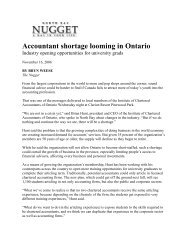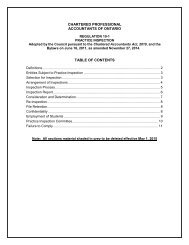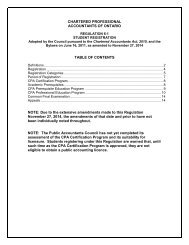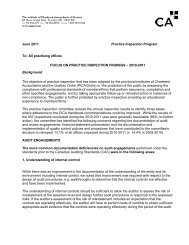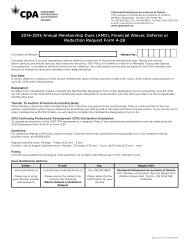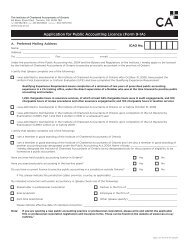CM Autumn Template - Institute of Chartered Accountants of Ontario
CM Autumn Template - Institute of Chartered Accountants of Ontario
CM Autumn Template - Institute of Chartered Accountants of Ontario
Create successful ePaper yourself
Turn your PDF publications into a flip-book with our unique Google optimized e-Paper software.
(From page 11)<br />
These top leaders, referred to by the authors as<br />
‘synergists’, can stand in the eye <strong>of</strong> the storm with what<br />
they refer to as “synergistic intuitions that can transform<br />
seemingly intractable conflicts into solutions that are<br />
beneficial to all parties.”<br />
An interesting finding in the survey was the fact that half <strong>of</strong><br />
this top one per cent were committed to meditation as a<br />
regular practice. This allowed them to be grounded, aware<br />
<strong>of</strong> their own feelings and the feelings <strong>of</strong> those around them<br />
and, very importantly, in real time while it’s happening, not<br />
after the fact. Is it only a matter <strong>of</strong> time before Meditation<br />
101 becomes part <strong>of</strong> the business school curriculum?<br />
There is some consensus among the experts and<br />
researchers:<br />
• CEOs are the organization’s top role model – how you<br />
talk, walk, dress, interact with and engage others, and<br />
go about your business are all keenly observed and<br />
emulated. You set the tone and the model for<br />
appropriate behavior. Begin practising early in your<br />
career.<br />
• You need to develop breadth – experience in various<br />
functional areas and different businesses, perhaps<br />
international exposure, and a second language can all<br />
be valuable. Continuous learning is your mantra.<br />
• You must develop your people skills – your ability to<br />
listen and synthesize information, empower and<br />
engage the team, articulate your vision, and persuade<br />
and influence stakeholders is an absolute requirement.<br />
Mark Palmer, an executive recruiter with his own firm in<br />
Toronto, has had his share <strong>of</strong> CEO assignments and has<br />
some insightful anecdotes on becoming CEO. He recalls a<br />
conversation he had with one <strong>of</strong> his clients who ran one <strong>of</strong> the<br />
most consistently pr<strong>of</strong>itable and best-managed companies in<br />
his industry. This client also had only a grade 10 education<br />
and is part <strong>of</strong> the minority, entrepreneur-turned-CEO class.<br />
���� ��������� ������� ��� ����� �������<br />
� ������ �� ���������� ������<br />
� ������� �� � ���������<br />
� ������� �� � ������<br />
� � ����� �������� � ���������� � ��<br />
������������� ���������<br />
12 CheckMark • <strong>Autumn</strong> 2009<br />
When asked why he has been so successful, the client<br />
replied: “Because I have no shareholders and do not need<br />
to focus exclusively on achieving the bottom line”. He<br />
added that the way in which he achieved the bottom line<br />
was equally important. He was also quick to point out that<br />
he surrounded himself with outstanding managers.<br />
Mark also relates the story <strong>of</strong> recruiting a president for the<br />
Canadian subsidiary <strong>of</strong> a U.S. parent. The U.S. parent was<br />
so pleased with Mark’s results that they invited him to<br />
undertake subsequent searches for all their senior<br />
executives in the U.S., with one condition. This was that<br />
half the candidates Mark would present would have<br />
Canadian business experience.<br />
When asked why, his client responded that Canadians<br />
make better general managers than Americans. He<br />
elaborated by stating that Americans tend to produce<br />
specialists while Canadians produce generalists, due to<br />
the sheer size <strong>of</strong> the respective markets. He felt Canadian<br />
managers were exposed to a broader perspective earlier<br />
on in their career and by the time they reached the<br />
executive suites, were trained to think in broader and <strong>of</strong>ten<br />
more strategic business terms.<br />
A final comment, and an obvious but important one, comes<br />
from Bob Muschewske <strong>of</strong> Personnel Decisions<br />
International. “You have to want to be at the top to be a<br />
successful CEO. This is not a role you fall into. Top leaders<br />
are comfortable calling the shots, persuading others about<br />
the decisions they think are right and taking the<br />
responsibility that goes along with the power position.”<br />
So, do you want to be a CEO?<br />
Guest contributor Robert Gagnon, CA, Associate Director,<br />
Pr<strong>of</strong>essional Development, oversees the <strong>Institute</strong>’s<br />
Executive Programs. The <strong>Institute</strong> is launching its own CEO<br />
executive program called ‘Becoming CEO and Staying<br />
There’. Developed and instructed by Dr. Jim Murray, the<br />
program will debut in the fall <strong>of</strong> 2010.<br />
�������� � ������� � ���������<br />
�������� ������������ � ������� ������������ � ������� ������� ������������ � ������������������



